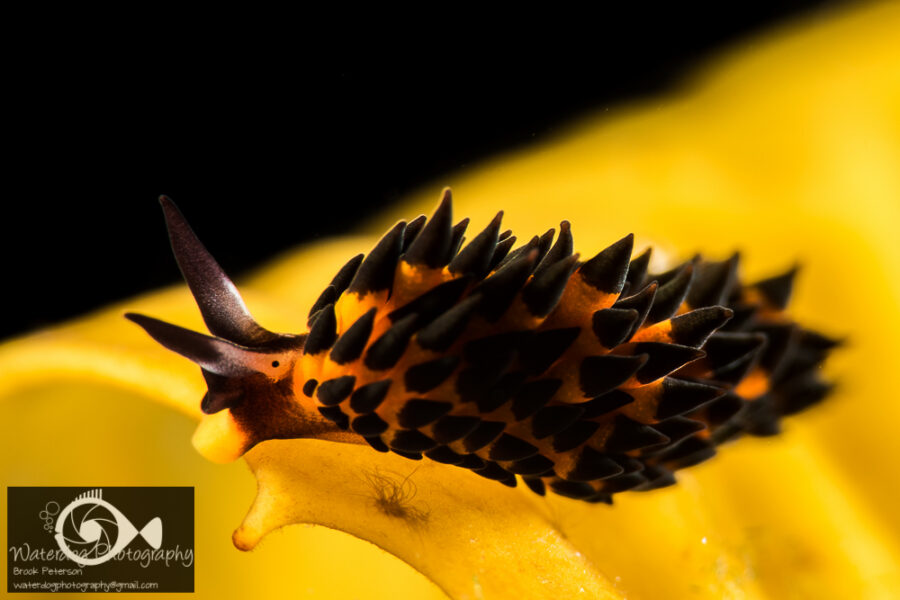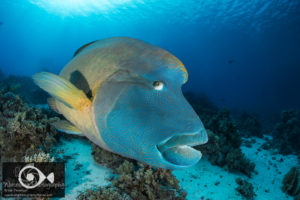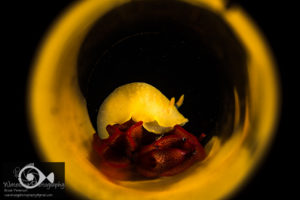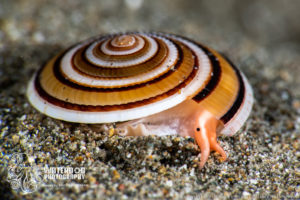During the summer of 2014, I went diving every week seeking photographs of these fantastic new inhabitants along our coast. Although I did see the changes in the ocean environment, such as the degradation of the kelp and the rapid invasion of Sargassum horneri, the new-to-our-waters “wild things” evaded my camera lens. In fact, I saw a huge decline in the sea life I had been accustomed to. Animals such as Sheep Crabs, horn sharks, and octopus that were once prolific at my favorite Catalina Island dive sites became scarce. Sea lions pups were suffering for lack of food and sometimes I would find them dead.

Sheep Crab picking flesh off a sea lion carcass.
One day in early October I decided to throw caution to the wind and set my camera up to take pictures of the miniature ocean world. After all, I hadn’t seen a whale shark even after weeks of searching, so I figured I would tempt Murphy’s law. My first two dives of the day revealed….nothing. Catalina Island was dead, I thought. On my third dive of the day, I was determined to find something small; maybe a skeleton shrimp or amphipod was still alive in these dismal waters. Searching through some green algae that was growing in shallow water, I suddenly saw a tiny flash of bright orange. I picked back through the algae, and to my utter astonishment, discovered it was a tiny orange and black nudibranch. I happily snapped about a hundred images of the slug until my tanks ran low and I had to abandon the tiny creature.

The first Placida brookae found on Catalina Island
I knew I had found something special. I had never seen anything like this before and had enough experience to know it was not a common animal in Southern California. So when I got home, I sent the pictures to some local marine biologists for identification. I was rewarded with an opinion from Dave Behrens, author of “Eastern Pacific Nudibranchs” that it was Placida cremoniana, a sacoglossan sea slug, probably migrated up from Baja, Mexico. However, a positive identification could not be concluded without a specimen.
The following week, I invited two of my friends and fellow photographers, Michael Ziegler and Todd Winner, to come dive with me to search for this tiny slug again in hopes of being able to collect some specimen for positive identification. It was literally like looking for a grain of rice in a vast ocean. But luckily my sharp-eyed friends found a rock that was home to a great many of the little nudibranchs and we were able to collect two. I dropped them off at the home of Dr. Angel Valdez, a biological scientist specializing in the study of such things. For the next three years he and his students would study the DNA of the slugs I collected. They determined that the species did not match any known Placida species. I was thrilled to find that I would be able to name the new species after my own name. I chose “Brook” rather than “Peterson” because I thought “Peterson” sounded like pig Latin when the name was Latinized. Thus the new slug in town is called Placida brookae.

Placida brookae
During the past three years, I have kept an eye out for more sightings of Placida brookae. During 2014 and 2015 I found them all around Catalina Island, and in late 2015 I found one over at Anacapa Island. But 2016 ended the warm water events and as the cold water returned to Southern California, Placida brookae seems to have disappeared. I hope to see them again. It is a mystery where they came from and if they have always been a part of the life cycle of Southern California seas, or if they were just passing through. In any case, I have a species named after me. Cool!
If you are truly interested, I have placed a link to the original paper describing this and a few other species of Placida sea slugs below. Just click here: Placida brookae
Join me for a workshop! Travel to a great destination where you will have exclusive coaching on your underwater photography. Meet new people, network, try new techniques, and learn with the pros! Click on Travel and Workshops for more information!






